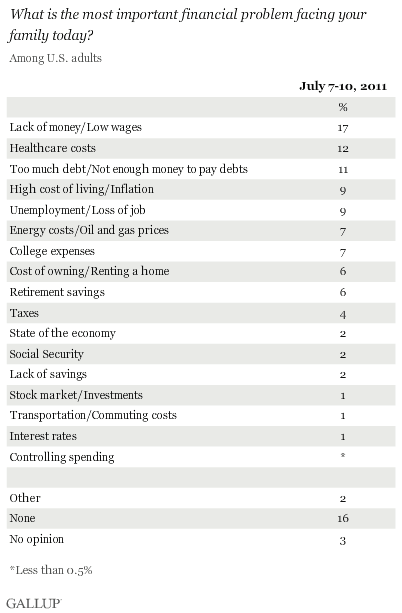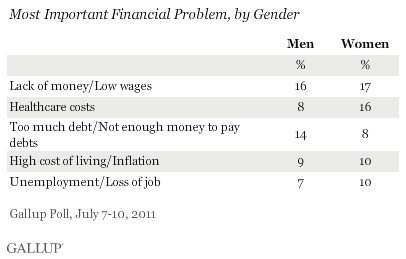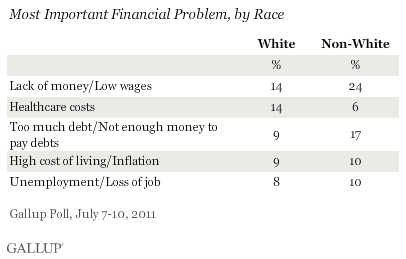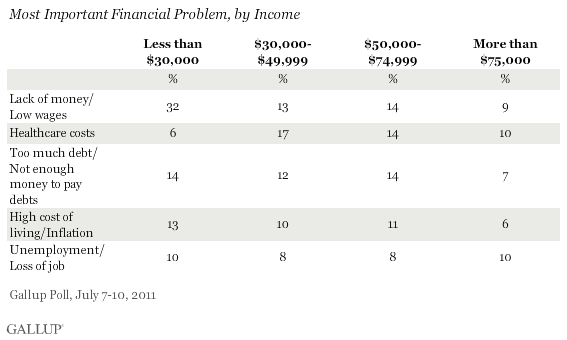WASHINGTON, D.C. -- Basic lack of money remains Americans' foremost financial concern. Even in the current job climate, 17% of Americans say the most important financial problem their family faces today is a lack of money compared with 9% who say it is unemployment or the loss of a job. The cost of healthcare takes second place as 12% say it is the most important financial problem for their family.

These findings are based on a July 7-10 Gallup poll asking the American public to name the most pressing financial problems facing their family today. Americans' top five concerns combined represent well over half of all financial concerns mentioned. Remarkably, these top five issues have remained virtually unchanged over the last two years.
However, such consistency does not translate into a uniform pattern of financial worries across demographic groups. Although men and women are equally likely to say their most important financial problem is a lack of money, healthcare costs are more likely to be an issue for women, while having too much debt is a greater concern for men. Men and women, however, are equally concerned about inflation and unemployment.

Even more pronounced are differences between whites and non-whites. Non-white Americans name a lack of money and having too much debt as the most important financial problems facing their families today. White Americans' top concerns are split evenly between healthcare costs and a lack of money. Both racial groups share similar levels of worry about inflation and unemployment.

Americans' top financial worries differ significantly by income. High-income Americans -- those with an annual income of at least $75,000 -- are less likely to mention any of the top five financial problems overall and no particular issue appears to dominate. These high-income Americans, on the other hand, are significantly more likely to mention retirement savings as their top problem than those with lower incomes.
Low-income adults (earning less than $30,000 annually), by far, name a lack of money as their most important financial problem. But significant proportions also report other money-related issues such as too much debt and the high cost of living.
Americans whose annual household income ranges between $30,000 and less than $75,000 are equally likely to cite lacking money, healthcare costs, high levels of debt and inflation as the most important financial problem for their family. However, individuals at the lower end of this income bracket (those whose household income is at least $30,000 but less than $50,000) are slightly more likely to say the cost of healthcare is their most important financial worry.
Interestingly, there is no difference across income groups in mentions of unemployment as the foremost financial problem facing their family.

Bottom Line
When asked to name the most important financial problem facing their family today, Americans are most likely to report not having enough money or having too much debt. Perhaps surprisingly, given the unemployment picture and near $4-per-gallon gasoline prices, Americans' top list of financial concerns has remained fairly constant over the last two years. For example in July 2008, when gas prices topped the $4 mark, 29% of Americans said energy and gas prices were the most important financial concern their family faced, the highest percentage Gallup had ever recorded for any financial issue since this question was first asked in 2005. Further, different demographic groups report having different financial worries, underscoring the various effects the challenging economic climate has on American families.
Survey Methods
Results for this Gallup poll are based on telephone interviews conducted July 7-10, 2011, with a random sample of 1,016 adults, aged 18 and older, living in the continental U.S., selected using random-digit-dial sampling.
For results based on the total sample of national adults, one can say with 95% confidence that the maximum margin of sampling error is ±4 percentage points.
Interviews are conducted with respondents on landline telephones and cellular phones, with interviews conducted in Spanish for respondents who are primarily Spanish-speaking. Each sample includes a minimum quota of 400 cell phone respondents and 600 landline respondents, with additional minimum quotas among landline respondents for gender within region. Landline numbers are chosen at random among listed telephone numbers, cell phone numbers are selected using random-digit dial methods. Landline respondents are chosen at random within each household on the basis of which member had the most recent birthday.
Samples are weighted by gender, age, race, Hispanic ethnicity, education, region, adults in the household, and phone status (cell phone only/landline only/both, having an unlisted landline number, and being cell phone mostly). Demographic weighting targets are based on the March 2010 Current Population Survey figures for the age 18+ non-institutionalized population living in U.S. telephone households. All reported margins of sampling error include the computed design effects for weighting and sample design.
In addition to sampling error, question wording and practical difficulties in conducting surveys can introduce error or bias into the findings of public opinion polls.
View methodology, full question results, and trend data.
For more details on Gallup's polling methodology, visit https://www.gallup.com/.
